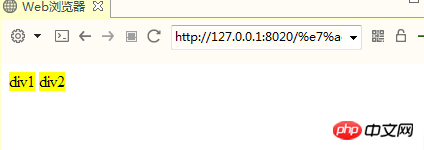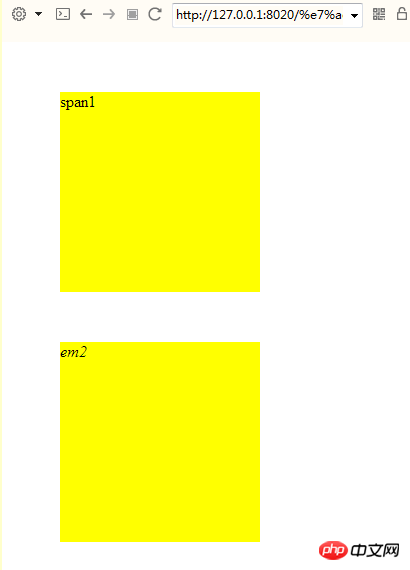 Web Front-end
Web Front-end
 CSS Tutorial
CSS Tutorial
 Detailed explanation of the conversion method between block elements and inline elements
Detailed explanation of the conversion method between block elements and inline elements
Detailed explanation of the conversion method between block elements and inline elements
1. Conversion between block elements and inline elements
Regarding the conversion between block-level elements and inline elements, we can use css to solve the problem. Use CSS to block elements. This difference from the attribute of inline elements does not become a difference. For example, we can add an attribute like display:block to the inline element, so that it also has the attribute of starting from a new line every time, that is, it becomes a block element. Similarly, we can add display: to the block element: Attributes like inline allow it to be arranged on one line.
2. display: inline and display: block
display: inline: Display as inline, so that fast elements are converted into inline elements and have the characteristics of inline element tags.
display: block: Display as a block, converting inline elements into block-level elements and having the characteristics of block element tags.
3. Convert block-level elements to inline elements, use display: inline.
nbsp;html>
<meta>
<title></title>
<style>
p{
height: 50px;
background-color: yellow;
width: 500px;
display: inline;
}
</style>
<p>p1</p>
<p>p2</p>
Code segment execution result:

#The block-level element has been successfully converted into an inline element, and it has the characteristics of an inline element.
4. Convert inline elements to block-level elements, use display: block.
nbsp;html>
<meta>
<title></title>
<style>
span, em{
height: 200px;
background-color: yellow;
width: 200px;
margin: 50px;
display: block;
}
</style>
<span>span1</span>
<em>em2</em>
Code snippet execution result:

#The inline element has been successfully converted into a block-level element and has the characteristics of a block-level element.
5. display
display: Converting the label to the type displayed on the page will not change the nature of the label.
The above is the detailed content of Detailed explanation of the conversion method between block elements and inline elements. For more information, please follow other related articles on the PHP Chinese website!

Hot AI Tools

Undresser.AI Undress
AI-powered app for creating realistic nude photos

AI Clothes Remover
Online AI tool for removing clothes from photos.

Undress AI Tool
Undress images for free

Clothoff.io
AI clothes remover

Video Face Swap
Swap faces in any video effortlessly with our completely free AI face swap tool!

Hot Article

Hot Tools

Notepad++7.3.1
Easy-to-use and free code editor

SublimeText3 Chinese version
Chinese version, very easy to use

Zend Studio 13.0.1
Powerful PHP integrated development environment

Dreamweaver CS6
Visual web development tools

SublimeText3 Mac version
God-level code editing software (SublimeText3)

Hot Topics
 1387
1387
 52
52
 Building an Ethereum app using Redwood.js and Fauna
Mar 28, 2025 am 09:18 AM
Building an Ethereum app using Redwood.js and Fauna
Mar 28, 2025 am 09:18 AM
With the recent climb of Bitcoin’s price over 20k $USD, and to it recently breaking 30k, I thought it’s worth taking a deep dive back into creating Ethereum
 Vue 3
Apr 02, 2025 pm 06:32 PM
Vue 3
Apr 02, 2025 pm 06:32 PM
It's out! Congrats to the Vue team for getting it done, I know it was a massive effort and a long time coming. All new docs, as well.
 Can you get valid CSS property values from the browser?
Apr 02, 2025 pm 06:17 PM
Can you get valid CSS property values from the browser?
Apr 02, 2025 pm 06:17 PM
I had someone write in with this very legit question. Lea just blogged about how you can get valid CSS properties themselves from the browser. That's like this.
 A bit on ci/cd
Apr 02, 2025 pm 06:21 PM
A bit on ci/cd
Apr 02, 2025 pm 06:21 PM
I'd say "website" fits better than "mobile app" but I like this framing from Max Lynch:
 Stacked Cards with Sticky Positioning and a Dash of Sass
Apr 03, 2025 am 10:30 AM
Stacked Cards with Sticky Positioning and a Dash of Sass
Apr 03, 2025 am 10:30 AM
The other day, I spotted this particularly lovely bit from Corey Ginnivan’s website where a collection of cards stack on top of one another as you scroll.
 Using Markdown and Localization in the WordPress Block Editor
Apr 02, 2025 am 04:27 AM
Using Markdown and Localization in the WordPress Block Editor
Apr 02, 2025 am 04:27 AM
If we need to show documentation to the user directly in the WordPress editor, what is the best way to do it?
 Comparing Browsers for Responsive Design
Apr 02, 2025 pm 06:25 PM
Comparing Browsers for Responsive Design
Apr 02, 2025 pm 06:25 PM
There are a number of these desktop apps where the goal is showing your site at different dimensions all at the same time. So you can, for example, be writing
 Let's use (X, X, X, X) for talking about specificity
Mar 24, 2025 am 10:37 AM
Let's use (X, X, X, X) for talking about specificity
Mar 24, 2025 am 10:37 AM
I was just chatting with Eric Meyer the other day and I remembered an Eric Meyer story from my formative years. I wrote a blog post about CSS specificity, and



